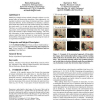Free Online Productivity Tools
i2Speak
i2Symbol
i2OCR
iTex2Img
iWeb2Print
iWeb2Shot
i2Type
iPdf2Split
iPdf2Merge
i2Bopomofo
i2Arabic
i2Style
i2Image
i2PDF
iLatex2Rtf
Sci2ools
ICMI
2010
Springer
2010
Springer
Focusing computational visual attention in multi-modal human-robot interaction
Identifying verbally and non-verbally referred-to objects is an important aspect of human-robot interaction. Most importantly, it is essential to achieve a joint focus of attention and, thus, a natural interaction behavior. In this contribution, we introduce a saliencybased model that reflects how multi-modal referring acts influence the visual search, i.e. the task to find a specific object in a scene. Therefore, we combine positional information obtained from pointing gestures with contextual knowledge about the visual appearance of the referred-to object obtained from language. The available information is then integrated into a biologically-motivated saliency model that forms the basis for visual search. We prove the feasibility of the proposed approach by presenting the results of an experimental evaluation. Categories and Subject Descriptors I.2.10 [Artificial Intelligence]: Vision and Scene Understanding-Perceptual reasoning; I.4.8 [Image Processing and Computer Vision]: Scene ...
Related Content
| Added | 12 Feb 2011 |
| Updated | 12 Feb 2011 |
| Type | Journal |
| Year | 2010 |
| Where | ICMI |
| Authors | Boris Schauerte, Gernot A. Fink |
Comments (0)

